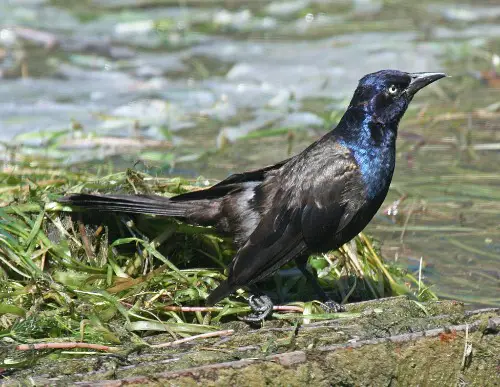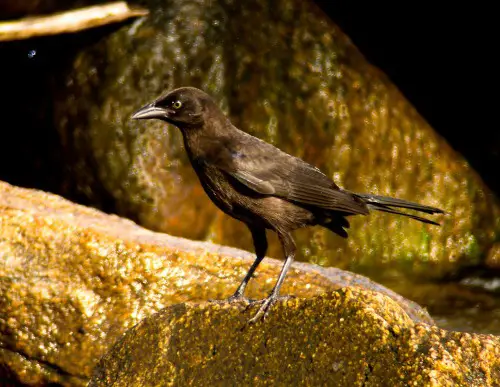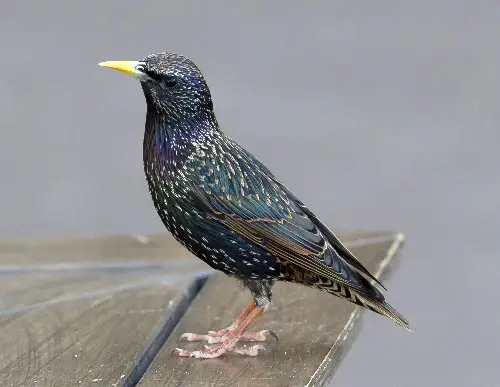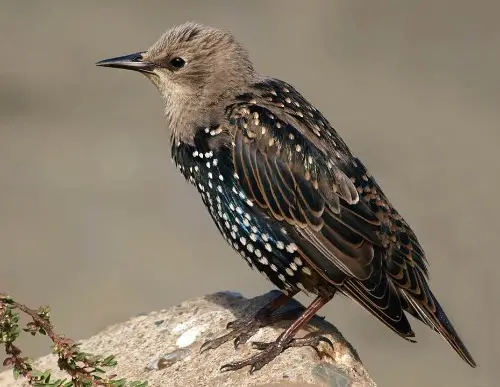Last Updated on: February 4, 2025
Among the many colorful and unique birds out there, some look pretty similar – take grackles and starlings, for example.
You’ve probably seen these two birds and mistook them for the same species. Considering their similar iridescent colors, you need to look at more minor details to tell them apart.
That’s exactly what we’re here for!
We prepared a comprehensive guide on how you can distinguish a grackle vs. starling. We also included some interesting facts so you can learn about them even more.
Main Differences Between Grackle Vs. Starling
The main differences between grackle vs. starling are:
- A grackle is generally larger and has a longer tail, whereas a starling is smaller and has a shorter tail.
- A grackle has dark legs, yellow eyes, and dark bill, whereas a starling has pinkish legs, black eyes, and yellow bill (summer).
- Grackles have sexual dimorphism (sexes look different), whereas starlings don’t.
Common Grackle (Quiscalus quiscula)
We’ll mainly talk about the Common Grackle, a native North American bird from the Troupials and Allies family (Icteridae).
There are other grackles in North America, such as the Great-Tailed Grackle (Quiscalus mexicanus) and the Boat-Tailed Grackle (Quiscalus major). However, they aren’t as common and widely distributed.
Appearance


Measurements (both sexes):
- Length: 11.0-13.4 in (28-34 cm)
- Weight: 2.6-5.0 oz (74-142 g)
- Wingspan: 14.2-18.1 in (36-46 cm)
The Common Grackle has glossy black feathers on the head, wings, and tail with a bluish-purple sheen. Meanwhile, the rest of its body shows a variety of bronze, green, purple, and blue iridescence.
However, you can only see these colors up close and with good lighting. Otherwise, this bird will only appear all-black.
Its long, dark legs, bright yellow eyes, and dark bill are other identifying characteristics. Additionally, grackle tails are long and rounded, folding into a V shape during flight.
Male and female grackles have some sexual dimorphism, a feature found in many species. In this case, females look duller than males.
Habitat
In North America, Common Grackles are found east of the Rocky Mountains and south of the tundra. They’re present all year in the eastern USA, while only during summer in the central USA and southeastern Canada.
If you live in the southwestern USA, you’ll see Great-Tailed Grackles instead.
Common Grackles inhabit many types of open to semi-open country, including agricultural fields, meadows, forest edges, city parks, and suburban lawns. You can usually see them perched on a telephone line or tree branch as they make harsh calls.
It’s pretty common to see them in noisy groups, as they tend to nest in colonies of 10-30, sometimes even over 100.
You can even see them flying overhead in large flocks during the evening as they head to their communal roosts. This occurs more frequently during late summer and throughout winter.
Diet
Common Grackles will eat almost anything, including various invertebrates, small fish, amphibians, reptiles, rodents, eggs and young of other birds, and vegetable matter. However, grackles prefer to eat crops (mainly corn).
Grackles often forage in a large flock, walking around lawns and fields while pecking for food.
Because of this feeding behavior, they usually dominate bird feeders and drive away smaller backyard birds. Ironically, grackles dislike safflower seeds despite their broad diet.
Interesting Facts
- Like ravens and crows, the Common Grackle can recognize the faces of human beings.
- In a grackle population, there are considerably more females than males. Female grackles have a smaller need for food, so they have better survivability than male grackles.
European Starling (Sturnus vulgaris)
The Common Starling, better known as the European Starling, is the only species of the starling family (Sturnidae) present in North America. Like the House Sparrow, this bird isn’t native to North America.
Appearance


Measurements (both sexes):
- Length: 7.9-9.1 in (20-23 cm)
- Weight: 2.1-3.4 oz (60-96 g)
- Wingspan: 12.2-15.8 in (31-40 cm)
European Starlings have a black plumage overall. During summer, the breeding birds have yellow bills and a green, purple, blue, and bronze iridescence on the body. Meanwhile, their winter plumage has dark brown and white spots, and they have dark bills instead.
Due to this iridescence, these birds may look all-black at a distance or in poor lighting.
Some of their other defining characteristics are their pinkish legs and black eyes.
Unlike grackles, female and male starlings look identical.
Habitat
The European Starling is common and widely distributed throughout North America. These birds are permanent residents throughout the USA, northern Mexico, and southern Canada. However, they extend their range to central Canada during summer.
You can easily find them in human settlements, including farms, suburbs, parks, and cities, usually perched on wires, buildings, and trees. However, they’re seldom found in undisturbed wilderness areas.
Starlings are sociable and noisy birds, but they gather in larger flocks during fall and winter.
Diet
European Starlings forage on the ground, usually in flocks. Their diet comprises various invertebrates, berries, fruits, and seeds. Additionally, they may eat nectar from flowers.
Like grackles, starlings can horde your bird feeder and quickly clear it out. They particularly enjoy cracked corn and sunflower seeds in tube feeders.
Interesting Facts
- In 1890, Eugene Schieffelin introduced the European Starling in Central Park, NYC. This is the same guy who sponsored the introduction of the House Sparrow in North America (isn’t that funny).
- European Starlings can distinguish different types of sugars. This is helpful for their survival because starlings can’t digest sucrose (table sugar).
Watch This!
Frequently Asked Questions
Do grackles and starlings flock together?
Yes. Starlings and grackles can form large flocks with other birds outside their nesting season. This makes it harder to identify these two birds, especially when mixed with other species.
How do you get rid of grackles and starlings?
Many people consider grackles and starlings pests. You can try installing feeders designed to deter larger birds, such as an upside-down suet feeder or a tube feeder without perches.
You can also offer nothing but safflower seed to discourage grackles. Meanwhile, starlings only visit suet feeders mixed with cracked corn or nuts, so try using plain suet instead. If these don’t work, then we recommend temporarily removing your feeders and nest boxes and emptying your bird bath.
You can also try hunting them. Even though grackles are native birds that are federally protected, there are circumstances where you can control them without needing a permit. But that’s a bit inhumane, so we recommend contacting your local wildlife service instead.
Are grackles and ravens the same bird?
Apart from starlings, grackles can also be mixed up with different species, such as ravens.
Grackles are from the Icteridae family, including blackbirds like the Red-Winged Blackbird. Meanwhile, ravens are from the Corvidae family, including jays and crows.
Conclusion
When identifying bird species, plumage color is usually our first indicator. However, this can create more confusion when differentiating grackles from starlings.
Whether you want to encourage their presence or shoo them away, identifying these birds is the first step to taking the appropriate action.
So, keep your eyes peeled for those legs, eyes, bills, and tails. It may be challenging at first, but you’ll be an experienced birder in no time with enough patience and dedication!

